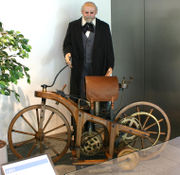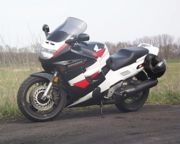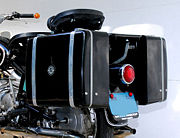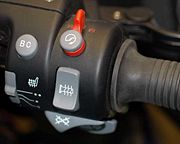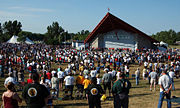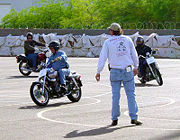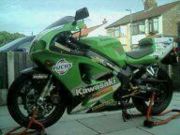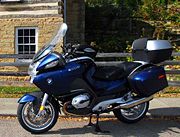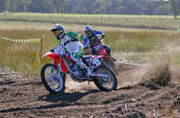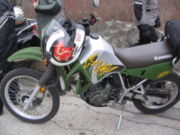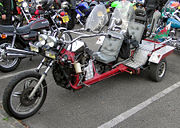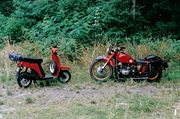Motorcycle
2008/9 Schools Wikipedia Selection. Related subjects: Road transport
A motorcycle or motorbike is a single-track, two-wheeled motor vehicle powered by an engine. Styles of motorcycles vary depending on the task for which they are designed, such as long distance travel, navigating congested urban traffic, cruising, sport and racing, or off-road conditions. In many parts of the world, motorcycles are among the least expensive and most widespread forms of motorised transport.
History

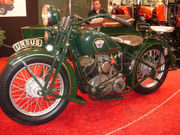
The inspiration for arguably the first motorcycle was designed and built by the German inventors Gottlieb Daimler and Wilhelm Maybach in Bad Cannstatt (since 1905 a city district of Stuttgart) in 1885. The first petroleum-powered vehicle, it was essentially a motorised bicycle, although the inventors called their invention the Reitwagen ("riding car").
However, if one counts two wheels with steam propulsion as being a motorcycle, then the first one may have been American. One such machine was demonstrated at fairs and circuses in the eastern U.S. in 1867, built by Sylvester Howard Roper of Roxbury, Massachusetts.
In 1894, Hildebrand & Wolfmüller became the first motorcycle available for purchase. In the early period of motorcycle history, many producers of bicycles adapted their designs to accommodate the new internal combustion engine. As the engines became more powerful, and designs outgrew the bicycle origins, the number of motorcycle producers increased.
Until the First World War, the largest motorcycle manufacturer in the world was Indian, producing over 20,000 bikes per year. By 1920, this honour went to Harley-Davidson, with their motorcycles being sold by dealers in 67 countries, until 1928 when DKW took over as the largest manufacturer.
After the Second World War, the BSA Group became the largest producer of motorcycles in the world, producing up to 75,000 bikes a year in the 1950s. The German company NSU Motorenwerke AG held the position of largest manufacturer from 1955 until the 1970s.
From the 1960s through the 1990s, small two-stroke motorcycles were popular worldwide, partly as a result of East German Walter Kaaden's engine work in the 1950s.
Today, the Japanese manufacturers, Honda, Kawasaki, Suzuki, and Yamaha dominate the motorcycle industry, although Harley-Davidson still maintains a high degree of popularity in the United States. Recent years have also seen a resurgence in the popularity of several other brands sold in the U.S. market, including BMW, KTM, Triumph, Aprilia, Moto Guzzi and Ducati.
Outside of the USA, these brands have enjoyed continued and sustained success, although Triumph, for example, has been re-incarnated from its former self into a modern world-class manufacturer. In overall numbers, however, the Chinese currently manufacture and sell more motorcycles than any other country and exports are rising. The quality of these machines is asserted to be somewhat lower than their Japanese, European and American counterparts.
Additionally, the small-capacity scooter is very popular through most of the world. The Piaggio group of Italy, for example, is one of the world's largest producers of two-wheeled vehicles. The scooter culture has, as yet, not been adopted widely in North America.
Technical aspects
Construction
Motorcycle construction is the engineering, manufacturing, and assembly of components and systems for a motorcycle which results in performance, cost and aesthetics desired by the designer. With some exceptions, construction of modern mass-produced motorcycles has standardised on a steel or aluminium frame, telescopic forks holding the front wheel, and disc brakes. A one- to eight-cylinder gasoline powered engine coupled to a manual, five- or six-speed sequential transmission drives the swingarm-mounted rear wheel by a chain, driveshaft or belt.
Fuel economy
Motorcycle fuel economy benefits from the relatively small mass of the vehicle, compared to its passengers and to other motor vehicles, and subsequent small engine displacement. However, poor aerodynamics of exposed passengers and engines designed for goals other than fuel economy can work to reduce these benefits. Riding style has a large effect on fuel economy: some riders report being able to double fuel economy by using low accelerations and lower speeds than usual, although this is the extreme case.
Fuel economy varies greatly with engine displacement and riding style ranging from a low of 29 mpg (U.S.) (8.1 l/100 km) reported by a Honda VTR1000F rider, to 107 mpg (U.S.) (2.2 l/100 km) reported for the Verucci Nitro 50 cc Scooter. A specially designed Matzu Matsuzawa Honda XL125 achieved 470 mpg (U.S.) (0.5 l/100 km) "on real highways - in real conditions."
Dynamics
Motorcycles must be leaned in order to turn. This lean can be induced by a method known as countersteering, in which the rider turns the handlebars in the direction opposite of the desired direction of turn. In other words, press forward on the handgrip in the desired direction—press right to go right, press left to go left. This concept is counter-intuitive and often very confusing to novices—and even to many experienced motorcyclists.
Short wheelbase motorcycles, such as sport bikes, can generate enough torque at the rear wheel and enough stopping force at the front wheel to lift the other wheel off the pavement. These actions, if performed on purpose, are known as wheelies and stoppies respectively. If carried past the point of recovery the resulting upset is known as "looping" the vehicle.
Additions
Various additions may be attached to a motorcycle or come as an integral part of a motorcycle from the factory.
- Fairing / screen
A plastic or fibreglass shell, known as a " fairing", is placed over the frame on some models to shield the rider from the wind, aid in aerodynamics and protect engine components in an accident. Drag is the major factor that limits motorcycle speed, as it increases at the square of the velocity, with the resultant required power increasing with the cube of velocity. As can be seen from the streamlined appearance of new performance motorcycles, there is much aerodynamic technology included in the design. Unfortunately, since the 1958 FIM ban on "dustbin" fairings no major manufacturer has been bold enough to overcome the effect of the turbulence caused by the spinning front wheel, which prevents the motorcycle from cutting a clean path through the air. The "dustbin" fairing can improve aerodynamic performance without unacceptably compromising the rider's ability to control the machine, although with a weight penalty.
Screens, also called windshields or windscreens, can be built into a fairing or be attached to an otherwise unfaired bike. They are usually made from transparent high-impact acrylic plastic. They may be shaped specifically to direct air flow over or around the head of the rider even if they are much shorter than the seated rider.
In the absence of a fairing or screen, a phenomenon known as the windsock effect occurs at speeds above 100 km/h (62 mph), where the rider becomes a major source of drag and is pushed back from the handlebars, tiring the rider. However, these motorcycles still effectively push their way through the atmosphere with brute force. A cabin cycle, which has a hull that wraps around the basic cycle frame, solved the problem of aerodynamics by isolating driver from outside air.
Modern fairings on touring and sport-touring motorcycles dramatically improve a rider's comfort and attention on long rides by reducing the effect of the wind and rain on the body. They also help keep a rider warm in cold weather or high wind chill conditions, reducing hypothermia. Heated hand grips, and even heated seats, also improve rider comfort in cold weather. Motorcycles from a number of manufacturers now have electric screens, introduced on the 1986 BMW K100LT, which raise and lower the screen with the push of a button to the optimum height for conditions.
- Saddlebags or panniers
Saddlebags or panniers mount on either side of the rear wheel behind the saddle to carry parts, tools, and/or travel gear. They can be made of fibreglass, ABS, leather, Cordura, or other appropriate sturdy material. They are normally standard items on touring motorcycles, but are usually optional on other types of motorcycles. They can be model-specific and available from a motorcycle's manufacturer, or after-market and designed to fit on numerous models.
- Heated hand grips/seats
As motorcycles lack climate control or proper protection from the wind, some manufacturers offer heated seats or hand grips to relieve the discomfort of low temperatures experienced during night riding or the colder months. They can also be added on as after market accessories and are powered by the bike's electrical system.
- Luggage rack
A common addition to many bikes is an attachment onto which bags or other luggage can be fastened. This removes the need for rider backpacks and is generally a more secure and safe way to add carrying capacity to a motorcycle.
- Sidecar
A sidecar is a one-wheeled device attached to the side of a motorcycle, producing a three-wheeled vehicle. Early sidecars were removable devices that could be detached from the motorcycle. Sidecars gradually superseded forecars and trailers. The forecar comprised a two-wheeled attachment at the front of the motorcycle. The trailer was just that, pulling the passenger along behind. In neither case could rider and passenger converse easily, and early sidecars were often called 'sociable' attachments.
- Trailer hitch
A trailer hitch or tow hitch is a device mounted on a motorcycle that enables it to tow a motorcycle trailer, usually to haul additional gear. No motorcycle manufacturer recommends trailer towing because it creates safety hazards for motorcyclists.
- Trunk
A motorcycle trunk is a storage compartment in the vicinity of the seat, other than panniers or saddlebags. A trunk mounted above and rear of the seat is called a top box.
Social aspects
Subcultures
Around the world, motorcycles have historically been associated with subcultures. Some of these subcultures have been loose-knit social groups such as the cafe racers of 1950s Britain, and the Mods and Rockers of the 1960s. A few are believed to be criminal gangs.
Social motorcyclist organisations are popular and are sometimes organised geographically, focus on individual makes, or even specific models. Example motorcycle clubs include: American Motorcyclist Association, Harley Owners Group, Moto Guzzi National Owners Club, Gold Wing Road Riders (GWRRA), and BMW MOA.
Many motorcycle organisations raise money for charities through organised events and rides. Some organisations hold large international motorcycle rallies in different parts of the world that are attended by many thousands of riders.
Some other motorcycle organisations exist only for the direct benefit of others. Bikers Against Child Abuse (BACA) is one example. BACA assigns members to individual children to help them through difficult situations, or even stay with the child if the child is alone or frightened.
In recent decades, motorcyclists have formed political lobbying organisations in order to influence legislators to introduce motorcycle-friendly legislation. One of the oldest such organisations, the British Motorcycle Action Group, was founded in 1973 specifically in response to helmet compulsion, introduced without public consultation. In addition, the British Motorcyclists Federation (BMF), originally founded in 1960 as a reaction to the public perception of motorcyclists as leather-jacketed hooligans, has itself moved into political lobbying.
Likewise, the U.S. has ABATE, which, like most such organisations, also works to improve motorcycle safety, as well as running the usual charity fund-raising events and rallies, often for motorcycle-related political interests. Some other lobbying organisations are listed in Category:Motorcyclists organizations.
Mobility
While the reasons for people choosing to ride motorcycles are many and varied, those reasons are increasingly practical, with riders opting for a powered two-wheeler as a cost-efficient alternative to infrequent and expensive public transport systems, or as a means of avoiding or reducing the effects of urban congestion. In places where it is permitted, lane splitting, also known as filtering, allows motorcycles to use the space between vehicles to move through stationary or slow traffic.
In the UK, motorcycles are exempt from the £8 per day London congestion charge other vehicles must pay to enter the city during the day. Motorcycles are also exempt from toll charges at some river crossings, such as the Severn Bridge, Dartford Crossing, and Mersey Tunnels. Some cities, such as Bristol, allow motorcycles to use bus lanes and provide dedicated free parking. In the United States, those states that have high-occupancy vehicle lanes also allow for motorcycle travel in them. Other countries have similar policies.
In many cultures motorcycles are the primary means of motorised transport. According to the Taiwanese government, for example, "the number of automobiles per ten thousand population is around 2,500, and the number of motorcycles is about 5,000."
Safety
Motorcycles have a higher rate of fatal accidents than automobiles. United States Department of Transportation data for 2005 from the Fatality Analysis Reporting System show that for passenger cars, 18.62 fatal crashes occur per 100,000 registered vehicles. For motorcycles this figure is higher at 75.19 per 100,000 registered vehicles – four times higher than for cars. The same data show that 1.56 fatalities occur per 100 million vehicle miles travelled for passenger cars, whereas for motorcycles the figure is 43.47 – 28 times higher than for cars. Furthermore for motorcycles the accident rates have increased significantly since the end of the 1990s, while the rates have dropped for passenger cars.
The two major causes of motorcycle accidents in the United States are: motorists pulling out or turning in front of motorcyclists and violating their rights-of-way and motorcyclists running wide through turns. The former is sometimes called a SMIDSY, an acronym formed from the motorists' common response of "Sorry mate, I didn't see you". The latter is more common when motorcyclists mix drinking with riding. Motorcyclists can anticipate avoid these crashes with proper training, increasing their conspicuousness to other traffic, and separating alcohol and riding.
The United Kingdom has a number of organisations which are dedicated to improving motorcycle safety by providing advanced rider training over and above what is necessary to pass the basic motorcycle test. These include the Institute of Advanced Motorists (IAM) and the Royal Society for the Prevention of Accidents (RoSPA). Along with increased personal safety, riders with these advanced qualifications often benefit from reduced insurance costs.
Motorcycle Safety Education is offered throughout the United States by a number of organisations ranging from state agencies to non-profit organisations to corporations. The courses, designed by the Motorcycle Safety Foundation (MSF), include a Basic Rider Course, an Intermediate Rider Course and an Advanced Rider Course.
In the UK and some Australian jurisdictions, such as New South Wales, the Australian Capital Territory and the Northern Territory, it is compulsory to undertake a rider training course before being issued a Learners Licence.
In Canada, motorcycle rider training is compulsory in Quebec and Manitoba only, but all provinces and territories have Graduated Licensing programs which place restrictions on new drivers until they have gained experience. Eligibility for a full motorcycle license or endorsement for completing a Motorcycle Safety course varies from province to province. The Canada Safety Council (CSC), a non-profit safety organisation, offers the Gearing Up program across Canada and is endorsed by the Motorcycle and Moped Industry Council. Training course graduates may qualify for reduced insurance premiums.
Types of motorcycles
There are three major types of motorcycle: street, off-road, and dual purpose. Within these types, there are many different sub-types of motorcycles for many different purposes.
Street
- Choppers: Highly customised motorcycles based on a cruiser-style frame with long rake (longer front forks) and wild paint jobs. Many are created more for show than rideability.

- Cruisers: A range of small to large motorcycles designed for comfort and looks with a relaxed upright or reclined seating position. They often use lots of chrome and may be highly customised.
- Electric motorcycles: Nearly silent, zero-emission electric motor-driven vehicles. Operating range and top speed suffer because of limitations of battery technology. Fuel cells and petroleum-electric hybrids are also under development to extend the range and improve performance of the electric motors.
- Mini bikes: Very small bikes designed to be simple run-around fun for both children and adults. Generally they have no hand-operated clutch or gearbox to simplify operation. Also known as Mini Motos. Not street-legal in most countries and jurisdictions. May be used for racing by all age levels.
- Mopeds: Small, light, inexpensive, efficient rides for getting around town. Usually started by pedalling (motorcycle + pedals = moped). Mopeds typically have an engine mouted to the frame with a chain supplying the drive force to the wheel.
- Naked bikes/Standard/Street bikes: Naked bikes have a riding position midway between the forward position of a sports bike and the reclined position of a cruiser. Unlike touring bikes, naked bikes often have little or no fairing (hence the title). Luggage capabilities are often an optional extra. Naked bikes are popular for commuting and other city riding as the upright riding position gives greater visibility in heavy traffic (both for the rider and to other road users) and are more comfortable than the hunched over sport bikes. Note that naked bike and standard are not fully interchangeable terms. Naked refers to the lack of bodywork and standard refers to the upright riding position.
- Scooters: Motorbikes with a step-through frame, generally smaller wheels than those of a traditional motorcycle and an engine mounted near the rear wheel on the swingarm. Can be ridden without straddling any part of the bike and usually features a floorboard. Available in sport, commuter, and touring models and wide variety of engine sizes from the standard 50 cc to 850 cc.
- Sport bikes: Fast, light, sleek motorcycles designed for maximum performance, for racing or spirited road riding. They are distinguishable by their full fairings and the rider's tipped-forward seating position. They are also called "race replicas" because of their connection to the racing category for production motorcycles known as Superbike racing, and earlier similar race series (the term arose in the 1980s). The power to weight ratio of the 900 cc+ models typically matches or exceeds one bhp of power for every one kg of mass.
- Racing bikes: Motorcycles designed for circuit or road racing, including mass-production motorcycles modified for motorcycle racing or sport riding.
- Street customs: Highly customised motorcycles with wild paint jobs also built for show, but constructed from a sport bike frame instead of a cruiser-style frame.
- Touring motorcycles: Touring bikes are designed for rider and passenger comfort, luggage carrying capacity, and reliability. Cruisers, sport bikes and some dual-sports can also be used as touring bikes with the addition of aftermarket luggage and sometimes seats. Common throughout the touring market are usually large-displacement fairings and windshields (for weather and wind protection), large-capacity fuel tanks (for long-range travel), engines optimised for progressive torque rather than highest possible power, and a more relaxed, basically upright seating position.
- Sport touring motorcycles: Sport-tourers combine attributes of a sport bike and a touring motorcycle. They are built for comfortable long-distance travel while maintaining a forward-leaning riding position, good handling, and high performance.
- Underbones: Small motorcycle which is a crossover between a scooter and a true motorcycle with step-through frame, popular in Southeast Asia. While the fuel tank for most motorcycles are tear-shaped and located at the top and just behind the instrument panel, the fuel tank for an underbone motorcycle is located under the seat.
Off-road
- Motocross bikes: Motorcycles designed for racing over closed circuits, often with jumps, over varied terrain of gravel/mud/sand. Sometimes simply called "dirt bikes" when not being raced, they can also be used for informal off-road recreation, or "mudding".
- Supermotos: Beginning in the mid-1990s, motocross machines fitted with street wheels and tyres similar to those used on Sport bikes began to appear. These are known as "Supermotards", and riders of these machines compete in specially organised rallies and races.
- Trials motorcycles: Motorcycles made as light as possible, with no seat (as they are designed to be ridden standing up), in order to provide maximum freedom of body positioning and stunt capability for use in observed trials competition.
Dual-purpose
- Dual-sports: Road-legal machines offering a compromise in highway and off-road performance, durability and comfort. Since the requirements are often conflicting, the manufacturer has to choose one or the other, resulting in a great variety of bikes in this category.
- Enduros: Road-legal versions of a motocross machine, i.e., featuring high ground clearance and copious suspension with minimal creature comforts. Highly unsuitable for long distance road travel. The features that differ from the motocross versions are the silencers, the flywheel weights and the presence of features necessary for highway use.
- Adventure Touring: Closely related to dual-sports, adventure tourers are motorcycles with lighter weight than just about any other bike considered a tourer, but heavier than any traditional dual-sport. Adventure tourers can handle with aplomb rough dirt paths such as fire roads however, for their weight they are generally not suited for anything more strenuous than that. The advantage is their increased number of luxury features and larger engines which make on-road riding much more enjoyable.
Motorcycle rider postures
The motorcyclist's riding position depends on the geometry of the rider's body combined with the geometry of the motorcycle itself, falling along a spectrum of three basic postures:
- Standard: In this position the rider sits roughly upright, in a neutral position, neither leaning forward nor rearward, knees lower than the hips, and feet roughly below the riders centre of gravity. The rider has excellent visibility and a higher seat height—but with greater wind resistance, a higher centre of gravity, and potentially more difficulty flat-footing—having the ability, when stationary, to put both feet flat on the ground for safety and comfort, keeping the machine upright.
- Sport: In this position the rider leans forward with the upper torso, supporting the upper-body weight with the back, stomach and leg muscles thereby keeping the forearms loose and relaxed providing smooth steering input/feedback at the handlebars. Knees are at hip height or below and squeezed against the tank to help support the upper body with the feet positioned on the balls of the foot on the footpegs. The position offers the advantage of decreased wind resistance but an otherwise cramped position that may be difficult to sustain for longer periods (some hours). The Sport riding position offers good flat-footing.
- Cruiser: In this position the rider sits at a lower seat-height with the upper torso upright to slightly rearward. Knees are near hip height and legs extended forward. This position offers the advantage of comfortable circulation to the legs and ease of flat-footing—though with a lower field of visibility. In this position the rider may have difficulty lifting off the seat (when crossing an obstacle for example).
Important factors of a motorcycle's ergonomic geometry that determine the seating posture include the height, angle and location of footpegs, seat and handlebars. Likewise, factors in a rider's physical geometry that contribute to seating posture include torso, arm, thigh and leg length, and overall rider height.
Legal definitions and restrictions
A motorcycle is broadly defined by law in some countries for the purposes of registration, taxation or licensing riders as a two-wheel motor vehicle "fit to drive." Other countries distinguish between mopeds and other small bikes and the larger, more powerful vehicles. In Canada and some U.S. jurisdictions, three-wheeled motor vehicles fall under the auspices of motorcycle regulations.
In the United Kingdom, the rules on which motorcycle may be ridden by whom are complex. A "moped", which can be ridden at age 16, has a maximum design speed not exceeding 50 km/h (31 mph) and engine capacity no greater than 50 cc. A "learner motorcycle", which can be ridden from age 17, has an engine up to 125 cc with a power output not exceeding 11 kW (14.8 hp). Only a Compulsory Basic Training (CBT) license is needed to ride a learner motorcycle. A "large restricted motorcycle", which has a power output of not more than 25 kW (33.5 hp). Riders are restricted to riding large restricted motorcycles or smaller for two years after passing their initial motorcycle test. A "large motorcycle", which has a power output of at least 25 kW (33.5 hp).
For riders over age 21 there is a direct access route to gaining a licence to ride a large motorcycle, which allows somebody with no motorcycle experience to train and pass a test in around five days. All motorcycle riders in the UK must first take a one-day CBT course, regardless of which class of motorcycle they intend to ride. In addition a theory test must be taken prior to taking a practical test for any type of motorcycle licence.
In New Zealand, "learner" and "restricted" motorcycles may only have a 250 cc engine capacity. This distinction draws some criticism, as it allows 15-year-old learner riders to operate bikes capable of reaching speeds in excess of 250 km/h (155 mph).
The laws of some countries allow anyone with a car licence to legally ride mopeds not exceeding 50 cc in capacity, meaning that they do not need to show any competency in handling such a vehicle.
The laws and regulations for legal moped usage in the U.S. vary by state. The specifics of the motorcycle and moped laws in the U.S. can be obtained from each individual state's Department of Motor Vehicles' websites.
